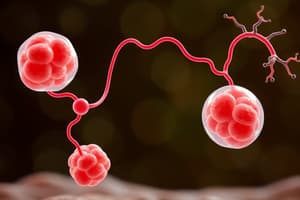Podcast
Questions and Answers
Where does the glycolysis process occur in cells?
Where does the glycolysis process occur in cells?
- Mitochondria
- Nucleus
- Cytosol (correct)
- Endoplasmic reticulum
What is the net gain of ATP molecules during glycolysis?
What is the net gain of ATP molecules during glycolysis?
- 4 ATP
- 2 ATP (correct)
- No ATP
- 6 ATP
What is the end product of glycolysis?
What is the end product of glycolysis?
- Glyceraldehyde-3-phosphate
- Fructose-1,6-bisphosphate
- Glucose-6-phosphate
- Pyruvate (correct)
Which enzyme is responsible for converting glucose into glucose-6-phosphate?
Which enzyme is responsible for converting glucose into glucose-6-phosphate?
What is the role of ATP in the regulation of glycolysis?
What is the role of ATP in the regulation of glycolysis?
What is the number of NADH molecules produced during glycolysis?
What is the number of NADH molecules produced during glycolysis?
Flashcards are hidden until you start studying
Study Notes
Overview of Glycolysis
- Glycolysis is a metabolic pathway that converts glucose (a 6-carbon sugar) into pyruvate (a 3-carbon molecule)
- Occurs in the cytosol of cells and is the first step in cellular respiration
- Does not require oxygen (anaerobic process)
Steps of Glycolysis
- Glucose phosphorylation: Glucose is converted into glucose-6-phosphate using one ATP molecule
- Phosphoglucose isomerase: Glucose-6-phosphate is converted into fructose-6-phosphate
- Aldolase: Fructose-6-phosphate is converted into fructose-1,6-bisphosphate
- Triosephosphate isomerase: Fructose-1,6-bisphosphate is converted into glyceraldehyde-3-phosphate and dihydroxyacetone phosphate
- Glyceraldehyde-3-phosphate dehydrogenase: Glyceraldehyde-3-phosphate is converted into 1,3-bisphosphoglycerate
- Phosphoglycerate kinase: 1,3-Bisphosphoglycerate is converted into 3-phosphoglycerate and ATP
- Phosphoglycerate mutase: 3-Phosphoglycerate is converted into 2-phosphoglycerate
- Enolase: 2-Phosphoglycerate is converted into enolpyruvate
- Pyruvate kinase: Enolpyruvate is converted into pyruvate and ATP
Net Gain of Glycolysis
- 2 ATP molecules are produced
- 2 NADH molecules are produced
- Pyruvate is produced, which can be used in the citric acid cycle or converted into lactate
Regulation of Glycolysis
- Allosteric regulation by ATP, ADP, and AMP
- Feedback inhibition by ATP and NADH
- Activation by fructose-2,6-bisphosphate and insulin
Studying That Suits You
Use AI to generate personalized quizzes and flashcards to suit your learning preferences.




